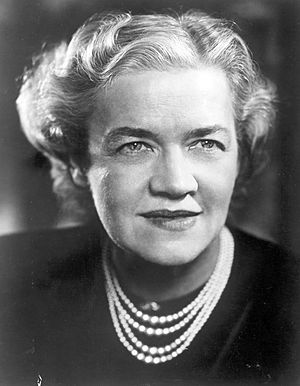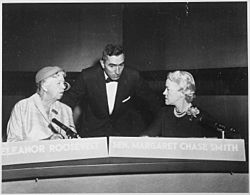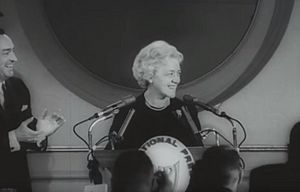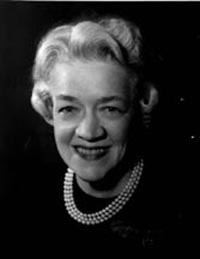Margaret Chase Smith facts for kids
Quick facts for kids
Margaret Chase Smith
|
|
|---|---|
 |
|
| Chair of the Senate Republican Conference | |
| In office January 3, 1967 – January 3, 1973 |
|
| Leader | Everett Dirksen Hugh Scott |
| Preceded by | Leverett Saltonstall |
| Succeeded by | Norris Cotton |
| United States Senator from Maine |
|
| In office January 3, 1949 – January 3, 1973 |
|
| Preceded by | Wallace H. White Jr. |
| Succeeded by | William Hathaway |
| Member of the U.S. House of Representatives from Maine's 2nd district |
|
| In office June 3, 1940 – January 3, 1949 |
|
| Preceded by | Clyde H. Smith |
| Succeeded by | Charles P. Nelson |
| Personal details | |
| Born |
Margaret Madeline Chase
December 14, 1897 Skowhegan, Maine, U.S. |
| Died | May 29, 1995 (aged 97) Skowhegan, Maine, U.S. |
| Political party | Republican |
| Spouse |
Clyde H. Smith
(m. 1930; died 1940) |
| Signature | |
Margaret Madeline Chase Smith (born December 14, 1897 – died May 29, 1995) was an important American politician. She was a member of the Republican Party. She served as a U.S. Representative from 1940 to 1949. Later, she became a U.S. Senator from 1949 to 1973, both representing the state of Maine.
She was the first woman to serve in both the House and the Senate. This made her the first woman to represent Maine in either part of the United States Congress. Margaret Chase Smith was also one of the first people to speak out against Joseph McCarthy. She did this in her famous 1950 speech, "Declaration of Conscience".
In 1964, Smith ran for the presidency. She was the first woman to be officially nominated for president at a major political party's meeting. When she left office, she was the longest-serving female senator ever. This record was later broken by Senator Barbara Mikulski in 2011.
Contents
Early Life and Education
Margaret Chase was born in Skowhegan, Maine. Her parents were George Emery and Carrie Matilda Chase. She was the oldest of six children. Her father was a barber, and her mother worked in different jobs.
Margaret started working at a local store when she was 12. She even bought her own life insurance policy. She also helped her father by shaving his customers. She went to Skowhegan High School and graduated in 1916.
In high school, she was the captain of the girls' basketball team. She also worked part-time for a telephone company. There, she met Clyde H. Smith, a local politician. He helped her get a job as an assistant to the tax assessor.
Starting Her Career
After high school, Margaret briefly taught at a one-room school. She also coached the girls' basketball team at Skowhegan High. She worked for a telephone company and then for a local newspaper. The newspaper was owned by Clyde Smith.
She became involved with women's groups. She helped start the Skowhegan chapter of the Business and Professional Women's Club. She was also the president of the statewide organization.
On May 14, 1930, Margaret Chase married Clyde Smith. He was 21 years older than her. She quickly became active in politics. She was elected to the Maine Republican State Committee.
When Clyde was elected to the U.S. House in 1936, Margaret went with him to Washington, D.C.. She worked as his secretary. She managed his office and helped write his speeches.
Serving in the U.S. House
In 1940, Clyde Smith became very sick. He asked Margaret to run for his House seat. He said she knew his ideas best and was qualified to continue his work. Clyde died on April 8, 1940.
Margaret won the special election to finish his term. She became the first woman elected to Congress from Maine. A few months later, she won a full two-year term. She was re-elected three more times, always winning by a large margin.
While in the House, Smith became very interested in military issues. She joined the House Naval Affairs Committee in 1943. She traveled 25,000 miles to visit bases during World War II. She was the only civilian woman to sail on a U.S. Navy ship during the war.
She supported laws that gave women a permanent place in the military. She helped pass the Women's Armed Services Integration Act in 1948. This law gave women official status in the armed forces.
Smith was known as a moderate Republican. She often disagreed with her own party. She supported many of President Franklin D. Roosevelt's New Deal programs. She also voted against making the House Un-American Activities Committee a permanent group.
She always wore a single red rose. This became a symbol for her throughout her career. She worked hard to make the rose the official flower of the United States. Congress finally approved this in 1987.
Serving in the U.S. Senate
The 1948 Election

In 1947, Senator Wallace H. White Jr. decided to retire. Margaret Chase Smith announced she would run for his seat in the U.S. Senate. She ran a campaign with little money. Her slogan was, "Don't change a record for a promise."
When asked if a woman could be a good Senator, Smith replied, "Women administer the home. They set the rules... It is an ideal experience for politics." She won the Republican primary election. Then, she won the general election by a large margin. She became the first woman to represent Maine in the Senate. She was also the first woman to serve in both houses of Congress.
Early Years in the Senate
Smith was sworn into the Senate on January 3, 1949. After a year, she gained national attention. She became the first member of Congress to speak out against Senator Joseph McCarthy. McCarthy was leading an anti-Communist "witch hunt."
Smith was initially interested in McCarthy's claims. But she became disappointed when he could not provide any proof. She said, "As an American, I condemn a Republican Fascist just as much as I condemn a Democrat Communist."
The Declaration of Conscience
On June 1, 1950, Smith gave a famous speech called the "Declaration of Conscience." In her speech, she criticized McCarthy's methods without naming him directly. She said he was using "unproved charges." She felt he had turned the Senate into a "forum of hate and character assassination."
She defended every American's right to speak freely and to have different beliefs. She warned that such tactics could harm the "American way of life." Six other Republican Senators supported her speech.
McCarthy reacted by calling Smith and the others "Snow White and the Six Dwarfs." He also removed her from a powerful committee. Smith later said that if she was remembered in history, it would be for this speech. She voted to officially criticize McCarthy in 1954.
In 1957, Smith became the first woman in Congress to break the sound barrier. She did this as a passenger in an F-100 Super Sabre jet.
The 1964 Presidential Election
On January 27, 1964, Smith announced she was running for President of the United States. She said, "I have few illusions and no money, but I'm staying for the finish." She lost all the primary elections. However, she did win 25% of the vote in Illinois.
At the 1964 Republican National Convention, she made history. She was the first woman to have her name officially placed in nomination for the presidency at a major party convention. She placed fifth in the voting.
Later Years in the Senate
During President John F. Kennedy's time, Smith believed the U.S. should be strong against the Soviet Union. Soviet leader Nikita Khrushchev called her "the devil in disguise of a woman." Smith replied that he was angry because American officials were becoming firmer.
After Kennedy's assassination in 1963, she placed a rose on his Senate desk. She supported the Vietnam War. She also supported the space program. NASA administrator James E. Webb said the U.S. might not have put a man on the Moon without her support.
Smith was the first woman to lead the Senate Republican Conference. This was a leadership position for Republicans in the Senate. She served from 1967 to 1972. She supported more money for education, civil rights, and Medicare.
She voted for the Civil Rights Acts of 1957, 1960, 1964, and 1968. She also supported the Voting Rights Act of 1965. She held a record for casting 2,941 votes in a row without missing any.
The 1972 Election
In 1972, she ran for re-election but lost to Democrat Bill Hathaway. This was the only election she ever lost in Maine. There were rumors about her health. She also didn't have a state office in Maine, which made some people feel she was out of touch. She lost the election by about 27,000 votes.
Awards and Honors
Margaret Chase Smith received many honors.
- In 1952, she was elected a Fellow of the American Academy of Arts and Sciences.
- In 1973, she was added to the National Women's Hall of Fame.
- In 1995, she received the Naval Heritage Award for supporting the U.S. Navy and military.
- President George H. W. Bush gave her the Presidential Medal of Freedom in 1989.
Later Life and Death
After leaving the Senate in 1973, Smith taught at several colleges. She moved back to Skowhegan, Maine. She oversaw the building of a library to hold her important papers.
Margaret Chase Smith died in Skowhegan in 1995 at age 97. She had a stroke eight days earlier. Her ashes were placed in the Margaret Chase Smith Library. She was the last living U.S. senator born in the 1800s.
Legacy and Recognition
- The Islesboro Ferry in Maine is named after her.
- A large painting of Smith hangs in the Maine State House.
- In 1958, an album was released where she spoke about women in politics.
- In 1961, she shared her favorite clam chowder recipe to support military families.
- In 1978, actress Patricia Neal played Senator Smith in a TV movie.
- In 1970, the twin Margaret Chase Smith bridges opened in her hometown.
- In 2007, the United States Postal Service issued a postage stamp to honor her.
- In 2010, a political group called "Maggie's List" was founded, named after her. It helps conservative women get elected.
- In 2022, a room in the United States Capitol was named the Margaret Chase Smith room. It was one of the first two rooms named after women senators.
See also
 In Spanish: Margaret Chase Smith para niños
In Spanish: Margaret Chase Smith para niños
- Chase family
- Women in the United States House of Representatives
- Women in the United States Senate




